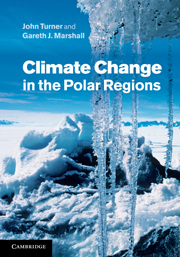Book contents
4 - The last million years
Published online by Cambridge University Press: 07 September 2011
Summary
Introduction
The period examined in this chapter extends back one million years, a time span that was chosen as encompassing the mid and late Quaternary and being slightly longer than the oldest Antarctic ice obtained at the time of writing: this was drilled at Dome C and extends back to ~800 kyr BP (years before AD 1950) (Parrenin et al., 2007). It also comprises the modern half of the Pleistocene (‘most recent’) epoch, a term originally coined by English geologist Charles Lyell in 1839. Throughout this period there has been the cyclic growth and decay of major Northern Hemisphere ice sheets through the exchange of mass between these ice sheets and the oceans.
On the notation used
Examining climate on this long-term timescale, using oxygen-isotope (δ18O) stratigraphy analysis of marine sediment cores and ice cores, has led to the development of a particular notation that allows direct comparison between records with differing sedimentation/accumulation rates. Emiliani (1955) introduced marine isotope stages (MIS) based on δ18O records derived from deep sea sediment cores. These MIS are time periods with boundaries at the mid-point between isotopic temperature maxima and minima of successive stages (Fig. 4.1). Beginning with MIS 1, which characterises the Holocene, odd and even stages represent interglacial and glacial periods further back in time, respectively: the exception is MIS 3, which was incorrectly identified as an interglacial when first defined and actually forms part of the last glacial with MIS 2 and MIS 4.
- Type
- Chapter
- Information
- Climate Change in the Polar Regions , pp. 162 - 193Publisher: Cambridge University PressPrint publication year: 2011

